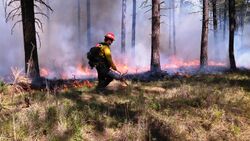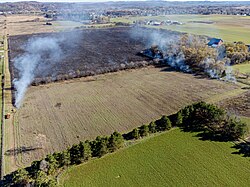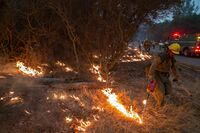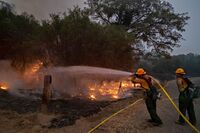Controlled burn
Topic: Biology
 From HandWiki - Reading time: 13 min
From HandWiki - Reading time: 13 min
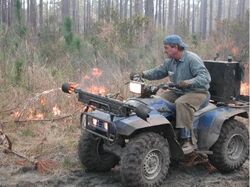
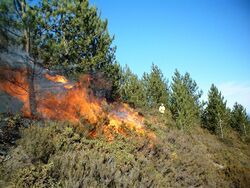
A controlled or prescribed (Rx) burn, which can include hazard reduction burning,[1] backfire, swailing or a burn-off,[2] is a fire set intentionally for purposes of forest management, fire suppression, farming, prairie restoration or greenhouse gas abatement. A controlled burn may also refer to the intentional burning of slash and fuels through burn piles.[3] Fire is a natural part of both forest and grassland ecology and controlled fire can be a tool for foresters.
Hazard reduction or controlled burning is conducted during the cooler months to reduce fuel buildup and decrease the likelihood of serious hotter fires.[4] Controlled burning stimulates the germination of some desirable forest trees, and reveals soil mineral layers which increases seedling vitality, thus renewing the forest. Some cones, such as those of lodgepole pine, sequoia and many chaparral shrubs are pyriscent, meaning heat from fire opens cones to disperse seeds.
In industrialized countries, controlled burning regulations and permits are usually overseen by fire control authorities.
History
There are two basic causes of wildfires. One is natural, mainly through lightning, and the other is human activity.[5] Controlled burns have a long history in wildland management. Pre-agricultural societies used fire to regulate both plant and animal life. Fire history studies have documented periodic wildland fires ignited by indigenous peoples in North America and Australia .[6][7] Native Americans frequently used fire to manage natural environments in a way that benefited humans and wildlife, starting low-intensity fires that released nutrients for plants, reduced competition, and consumed excess flammable material that otherwise would eventually fuel high-intensity, catastrophic fires.[8][9][10][11]
Fires, both naturally caused and prescribed, were once part of natural landscapes in many areas. In the US, these practices ended in the early 20th century, when federal fire policies were enacted with the goal of suppressing all fires.[7] Since 1995, the US Forest Service has slowly incorporated burning practices into its forest management policies.[12]
Fire suppression has changed the composition and ecology of North American habitats, including highly fire-dependent ecosystems such as oak savannas[13][14] and canebrakes,[15][16] which are now critically endangered habitats on the brink of extinction. In the Eastern United States, fire-sensitive trees such as the red maple are increasing in number, at the expense of fire-tolerant species like oaks.[17]
Controversies
The Oregon Department of Environmental Quality began requiring a permit for farmers to burn their fields in 1981, but the requirements became stricter in 1988 following a multi-car collision[18] in which smoke from field burning near Albany, Oregon, obscured the vision of drivers on Interstate 5, leading to a 23-car collision in which 7 people died and 37 were injured.[19] This resulted in more scrutiny of field burning and proposals to ban field burning in the state altogether.[20][21]
In the European Union, burning crop stubble after harvest is used by farmers for plant health reasons under several restrictions in cross-compliance regulations.[22]
With controlled burns, there is also a risk that the fires get out of control. For example, the Calf Canyon/Hermits Peak Fire, the largest wildfire in the history of New Mexico, was started by two distinct instances of controlled burns, which had both been set by the US Forest Service, getting out of control and merging.[23]
In the north of Great Britain, large areas of grouse moors are managed by burning in a practice known as muirburn. This kills trees and grasses, preventing natural succession, and generates the mosaic of ling (heather) of different ages which allows very large populations of red grouse to be reared for shooting.[24] The peat-lands are some of the largest carbon sinks in the UK, providing an immensely important ecological service. The governments has restricted burning to the area but hunters have been continuing to set the moors ablaze, releasing a large amount of carbon into the atmosphere and destroying native habitat.[25]
The conflict of controlled burn policy in the United States has roots in historical campaigns to combat wildfires and to the eventual acceptance of fire as a necessary ecological phenomenon. Following colonization of North America, the US used fire suppression laws to eradicate the indigenous practice of prescribed fire. This was done against scientific evidence that supported prescribed burns as a natural process. At the loss to the local environment, colonies utilized fire suppression in order to benefit the logging industry. [26]
The notion of fire as a tool had somewhat evolved by the late 1970s as the National Park Service authorized and administered controlled burns.[27] Following prescribed fire reintroduction, the Yellowstone fires of 1988 occurred, which significantly politicized fire management. The ensuing media coverage was a spectacle that was vulnerable to misinformation. Reports drastically inflated the scale of the fires which disposed politicians in Wyoming, Idaho, and Montana to believe that all fires represented a loss of revenue from tourism.[27] [28] Paramount to the new action plans is the suppression of fires that threaten the loss of human life with leniency toward areas of historic, scientific, or special ecological interest.[29]
There is still a debate amongst policy makers about how to deal with wildfires. Senators Ron Wyden and Mike Crapo of Oregon and Idaho have been moving to reduce the shifting of capital from fire prevention to fire suppression following the harsh fires of 2017 in both states.[30]
Tensions around fire prevention continue to rise due to the increasing prevalence of climate change. As drought conditions worsen, North America has been facing an abundance of destructive wildfires.[31] Since 1988, many states have made progress toward controlled burns. In 2021, California increased the amount of trained personnel to perform controlled burns and created more accessibility for landowners.[32]
Uses
Forest use
Controlled burning reduces fuels, may improve wildlife habitat,[33] controls competing vegetation,[34] improves short term forage for grazing, improves accessibility, helps control tree disease, and perpetuates fire dependent species.[35][36] To improve the application of prescribed burns for conservation goals, which may involve mimicking historical or natural fire regimes, scientists assess the impact of variation in fire attributes.[37] Fire frequency is the most discussed fire attribute in the scientific literature, likely because it is considered the most critical fire regime aspect.[38] Scientists less often report data concerning the effects of variation in other fire attributes (i.e., intensity, severity, patchiness, spatial scale, or phenology), even though these also likely impact conservation goals.[38]
Furthermore, low-intensity fire treatments can be administered in places where mechanized treatments such as disc harrowing cannot.[39][40] In some areas where grasses and herbaceous plants thrive, species variation and cover can drastically increase a few years after fuel treatments.[41]
Many trees depend on fire as a successful way to clear out the competition and release their seeds. In particular, the giant sequoia depends on fire to reproduce: the cones of the tree open after a fire releases their seeds, the fire having cleared all competing vegetation.[42]
Eucalyptus regnans or mountain ash of Australia also depends on fire but in a different fashion. The plant structure shows a unique evolution with fire, quickly replacing damaged buds or stems in the case of danger. They carry their seeds in capsules which can be deposited at any time of the year. During a wildfire, the capsules drop nearly all of their seeds and the fire consumes the eucalypt adults, but most of the seeds survive using the ash as a source of nutrients. At their rate of growth, they quickly dominate the land and a new eucalyptus forest grows.[43]
Agricultural use
In addition to forest management, controlled burning is also used in agriculture. In the developing world, this is often referred to as slash and burn. In industrialized nations, it is seen as one component of shifting cultivation, as a part of field preparation for planting. Often called field burning, this technique is used to clear the land of any existing crop residue as well as kill weeds and weed seeds. Field burning is less expensive than most other methods such as herbicides or tillage, but because it produces smoke and other fire-related pollutants, its use is not popular in agricultural areas bounded by residential housing.[44]
Prescribed fires are broadly used in the context of woody plant encroachment, with the aim of improving the balance of woody plants and grasses in shrublands and grasslands.[45][46][47][48]
In Northern-India, especially, In Punjab, Haryana, and Uttar Pradesh, crop residue burning is a major problem. CRB leads to degradation in environmental quality in these and neighboring states including in the capital of India, New Delhi.[49]
In East Africa, bird densities increased months after controlled burning had occurred.[50]
Procedure
Depending on the context and goals of a prescribed fire, additional planning may be necessary. While the most common driver of fuel treatment is the prevention of loss of human life, certain parameters can also be changed to promote biodiversity and to rearrange stand ages appropriately.
For the burning of slash, waste materials left over from logging, there are several types of controlled burns. Broadcast burning is the burning of scattered slash over a wide area. Pile burning is gathering up the slash into piles before burning. These burning piles may be referred to as bonfires. High temperatures can harm the soil, damaging it physically, chemically or sterilizing it. Broadcast burns tend to have lower temperatures and will not harm the soil as much as pile burning,[51] though steps can be taken to treat the soil after a burn. In lop and scatter burning, slash is left to compact over time, or is compacted with machinery. This produces a lower intensity fire, as long as the slash is not packed too tightly.[51]
The risk of fatal fires can also be reduced proactively by reducing ground fuels before they can create a fuel ladder and begin an active crown fire. Predictions show thinned forests lead to mitigated fire intensity and flame length compared to untouched or fire-proofed areas.[52]
Back burning is the term given to the process of lighting vegetation in such a way that it has to burn against the prevailing wind. This produces a slower moving and more controllable fire. While controlled burns utilize back burning during planned fire events to create a "black line", back burning or backfiring is also done to stop a wildfire that is already in progress. Firebreaks are also often used as an anchor point to start a line of fires along natural or man-made features such as a river, road or a bulldozed clearing.[53]
To minimise the impact of smoke, burning should be restricted to daylight hours whenever possible.[54]
Greenhouse gas abatement

Controlled burns on Australian savannas can result in a long-term cumulative reduction in greenhouse gas emissions. One working example is the West Arnhem Fire Management Agreement, started to bring "strategic fire management across 28,000 square kilometres (11,000 sq mi) of Western Arnhem Land" to partially offset greenhouse gas emissions from a liquefied natural gas plant in Darwin, Australia. Deliberately starting controlled burns early in the dry season results in a mosaic of burnt and unburnt country which reduces the area of stronger, late dry season fires;[56][57] it is also known as "patch burning".
See also
- Agroecology
- Cultural burning
- Fire ecology
- Fire-stick farming
- Native American use of fire in ecosystems
- Wildfire suppression
References
- ↑ "What is Hazard Reduction". http://www.hillside.rfsa.org.au/fwhaz.htm.
- ↑ Gage, Nicola (25 August 2016). "Burn-off rule change upsets Adelaide Hills residents". https://www.abc.net.au/news/2016-08-25/burn-off-rule-change-upsets-adelaide-hills-residents/7786080.
- ↑ "Managing Brush Fires". February 2017. http://pods.dasnr.okstate.edu/docushare/dsweb/Get/Document-9405/NREM-2894web.pdf.
- ↑ Guidelines for Low Intensity Bushfire Hazard Reduction Burning Retrieved on 11-3-2009
- ↑ "Fire Management Study Unit". Georgia Forestry Commission. http://www.fs.usda.gov/Internet/FSE_DOCUMENTS/fsm9_028958.pdf.
- ↑ R.A. Bradstock; M. Bedward; B.J. Kenny; J. Scott (1998). "Spatially-explicit simulation of the effect of prescribed burning on fire regimes and plant extinctions in shrublands typical of south-eastern Australia". Biological Conservation 86 (1): 83–95. doi:10.1016/S0006-3207(97)00170-5.
- ↑ 7.0 7.1 Scott L. Stephens; Robert E. Martin; Nicholas E. Clinton (2007). "Prehistoric fire area and emissions from California's forests, woodlands, shrublands, and grasslands". Forest Ecology and Management 251 (3): 205–216. doi:10.1016/j.foreco.2007.06.005.
- ↑ "Chapter Introduction: Fire Ecology". https://www.blm.gov/or/resources/recreation/tablerock/files/fire_ecol_intro.pdf.
- ↑ Palmer, Jane (29 March 2021). "Fire as Medicine: Learning from Native American Fire Stewardship". https://eos.org/features/fire-as-medicine-learning-from-native-american-fire-stewardship.
- ↑ Sten, Michaela. "Fire-Adapted: Plants and Animals Rely on Wildfires for Resilient Ecosystems". https://defenders.org/blog/2020/07/fire-adapted-plants-and-animals-rely-wildfires-resilient-ecosystems.
- ↑ Hoffman, Kira; Christianson, Amy; Dickson-Hoyle, Sarah (31 March 2022). "The right to burn: barriers and opportunities for Indigenous-led fire stewardship in Canada". FACETS 7 (January 2022): 464–481. doi:10.1139/facets-2021-0062.
- ↑ Scott L. Stephens; Lawrence W. Ruth (2005). "Federal Forest-Fire Policy in the United States". Ecological Applications 15 (2): 532–542. doi:10.1890/04-0545.
- ↑ "Oak Savannas: characteristics, restoration and long term management". https://oaksavannas.org.
- ↑ "Barrens and Savannas communities of Wisconsin". https://dnr.wi.gov/topic/EndangeredResources/Communities.asp?mode=group&Type=Barrens%20and%20Savannas.
- ↑ Cockman, Crystal. "The loss of the great canebrakes". UNC Charlotte Urban Institute. https://ui.charlotte.edu/story/loss-great-canebrakes.
- ↑ Shoemaker, Cory M. (2018). "Environmental and landscape factors affecting the continued suppression of canebrakes (Arundinaria gigantea, Poaceae) within restorations of bottomland hardwood forests". The Journal of the Torrey Botanical Society 145 (2): 156–152. doi:10.3159/TORREY-D-17-00011.1.
- ↑ Highfield, Craig (21 November 2018). "Foresters' conflicted love for red maple highlights its various roles". https://www.bayjournal.com/columns/message_from_the_alliance/foresters-conflicted-love-for-red-maple-highlights-its-various-roles/article_1da6b161-5645-591f-881a-439aa40ccc24.html.
- ↑ [1]
- ↑ [2]
- ↑ 2008 [|permanent dead link|dead link}}]
- ↑ Mortensen, Camilla. "Blowing Smoke". Eugene Weekly. http://www.eugeneweekly.com/2008/07/24/coverstory.html.
- ↑ "GAEC 6: Maintaining the level of organic matter in soil - Guide to cross compliance in England: 2016 - Guidance - GOV.UK". https://www.gov.uk/guidance/guide-to-cross-compliance-in-england-2016/gaec-6-maintaining-the-level-of-organic-matter-in-soil.
- ↑ Romero, Simon (21 June 2022). "The Government Set a Colossal Wildfire. What Are Victims Owed?". New York Times. https://www.nytimes.com/2022/06/21/us/new-mexico-wildfire-forest-service.html.
- ↑ Shrubsole, Guy; Cameron, Alasdair (24 February 2019). "Friends of the Earth sparks moorland burning investigation". Friends of the Earth. https://friendsoftheearth.uk/climate-change/friends-earth-sparks-moorland-burning-investigation.
- ↑ Dowler, Emma Howard, Crispin (2022-05-30). "Satellites reveal widespread burning on England's protected peatlands, despite government ban" (in en-GB). https://unearthed.greenpeace.org/2022/05/30/satellites-fires-burning-england-peatland-grouse-shooting/.
- ↑ Vinyeta, Kirsten (2021-10-12). "Under the guise of science: how the US Forest Service deployed settler colonial and racist logics to advance an unsubstantiated fire suppression agenda". Environmental Sociology 8 (2): 134–148. doi:10.1080/23251042.2021.1987608. ISSN 2325-1042. http://dx.doi.org/10.1080/23251042.2021.1987608.
- ↑ 27.0 27.1 Rothman, Hal K. (2005). A Test of Adversity and Strength: Wildland Fire in the National Park System. U.S. National Park Service. pp. 186.
- ↑ Franke, Mary Ann (2000). Yellowstone in the Afterglow: Lessons from the Fires. pp. 41. https://archive.org/details/yellowstoneinaft00fran.
- ↑ "Forest Service Wilderness Fire Policy". http://www.wilderness.net/fire.
- ↑ "Wyden renews call for Congress to fix wildfire funding" (in en-US). OregonLive.com. http://www.oregonlive.com/wildfires/index.ssf/2017/09/wyden_renews_call_for_congress.html.
- ↑ Mueller, Stephanie E.; Thode, Andrea E.; Margolis, Ellis Q.; Yocom, Larissa L.; Young, Jesse D.; Iniguez, Jose M. (2020-03-15). "Climate relationships with increasing wildfire in the southwestern US from 1984 to 2015" (in en). Forest Ecology and Management 460: 117861. doi:10.1016/j.foreco.2019.117861. ISSN 0378-1127. https://www.sciencedirect.com/science/article/pii/S0378112719314744.
- ↑ "Bill Text - AB-642 Wildfires.". https://leginfo.legislature.ca.gov/faces/billNavClient.xhtml?bill_id=202120220AB642.
- ↑ Palmer, W. E.; Engstrom, R. T.; Brennan, L. A. (2011-06-16). "Whither wildlife without fire?". Transactions of the 63rd North American Wildlife and Natural Resources Conference; 1998 March 20–25; Orlando, Fl. Washington, DC: Wildlife Management Institute: 402-414 (Treesearch.fs.fed.us). http://www.treesearch.fs.fed.us/pubs/443. Retrieved 2011-06-25.
- ↑ Franklin, Caroline M.A.; Nielsen, Scott E.; Macdonald, S. Ellen (September 2019). "Understory vascular plant responses to retention harvesting with and without prescribed fire" (in en). Canadian Journal of Forest Research 49 (9): 1087–1100. doi:10.1139/cjfr-2018-0288. ISSN 0045-5067. http://www.nrcresearchpress.com/doi/10.1139/cjfr-2018-0288.
- ↑ "Reasons For Prescribed Fire In Forest Resource Management - A Guide for Prescribed Fire in Southern Forests". Bugwood.org. 2003-03-24. http://www.bugwood.org/pfire/reasons.html.
- ↑ "Louisiana Pine Snake: (Pituophis ruthveni)". http://www.fws.gov/southwest/clearlakees/PDF/PINESNAKE.pdf. "The suppression of natural fire events may represent the greatest threat to the Louisiana pine snake in recent years, decreasing both the quantity and quality of habitat available to pine snakes. The longleaf-pine savannah forest evolved as a fire-climax community, adapted to the occurrence of frequent, but low-intensity, ground fires."
- ↑ Bowman, D.M.; Perry, G.L.; Higgins, S.I.; Johnson, C.N.; Fuhlendorf, S.D.; Murphy, B.P. (2016). "Pyrodiversity is the coupling of biodiversity and fire regimes in food webs". Philosophical Transactions of the Royal Society B: Biological Sciences 371 (1696). doi:10.1098/rstb.2015.0169. PMID 27216526.
- ↑ 38.0 38.1 Mason, D.S.; Lashley, M.A. (2021). "Spatial scale in prescribed fire regimes: an understudied aspect in conservation with examples from the southeastern United States.". Fire Ecology 17 (1): 1–14. doi:10.1186/s42408-020-00087-9.
- ↑ "Guidance for the controlled burning of heather, grass and other moorland, in Scotland and other moorland, in Scotland". http://www.scotland.gov.uk/Publications/2004/11/20194/46113.
- ↑ Bargeron, Charles T.. "Reasons For Prescribed Fire In Forest Resource Management - A Guide for Prescribed Fire in Southern Forests". https://www.bugwood.org/pfire/reasons.html.
- ↑ Havrilla, Caroline A.; Faist, Akasha M.; Barger, Nichole N. (2017). "Understory Plant Community Responses to Fuel-Reduction Treatments and Seeding in an Upland Piñon-Juniper Woodland" (in en). Rangeland Ecology & Management 70 (5): 609–620. doi:10.1016/j.rama.2017.04.002.
- ↑ Shellhammer, Howard S.; Shellhammer, Thomas H. (October 2006). [342:gssgts2.0.co;2 "Giant Sequoia (Sequoiadendron Giganteum [Taxodiacea]) Seedling Survival and Growth in the First Four Decades Following Managed Fires"]. Madroño 53 (4): 342–350. doi:10.3120/0024-9637(2006)53[342:gssgts2.0.co;2]. ISSN 0024-9637. http://dx.doi.org/10.3120/0024-9637(2006)53[342:gssgts]2.0.co;2.
- ↑ Waters, David A.; Burrows, Geoffrey E.; Harper, John D. I. (April 2010). "Eucalyptus regnans (Myrtaceae): A fire-sensitive eucalypt with a resprouter epicormic structure" (in en). American Journal of Botany 97 (4): 545–556. doi:10.3732/ajb.0900158. PMID 21622417.
- ↑ "State of Oregon: Smoke and Field Burning - Field Burning". https://www.oregon.gov/oda/programs/MarketAccess/SmokeBurning/Pages/FieldBurning.aspx.
- ↑ Trollope, W.S.W. (January 1980). "Controlling bush encroachment with fire in the savanna areas of South Africa" (in en). Proceedings of the Annual Congresses of the Grassland Society of Southern Africa 15 (1): 173–177. doi:10.1080/00725560.1980.9648907. ISSN 0072-5560. http://www.tandfonline.com/doi/abs/10.1080/00725560.1980.9648907.
- ↑ Smit, Izak P. J.; Asner, Gregory P.; Govender, Navashni; Vaughn, Nicholas R.; van Wilgen, Brian W. (October 2016). Kardol, Paul. ed. "An examination of the potential efficacy of high‐intensity fires for reversing woody encroachment in savannas" (in en). Journal of Applied Ecology 53 (5): 1623–1633. doi:10.1111/1365-2664.12738. ISSN 0021-8901. https://besjournals.onlinelibrary.wiley.com/doi/10.1111/1365-2664.12738.
- ↑ Twidwell, Dirac; Fuhlendorf, Samuel D.; Taylor, Charles A.; Rogers, William E. (June 2013). Kardol, Paul. ed. "Refining thresholds in coupled fire–vegetation models to improve management of encroaching woody plants in grasslands" (in en). Journal of Applied Ecology 50 (3): 603–613. doi:10.1111/1365-2664.12063. ISSN 0021-8901. https://besjournals.onlinelibrary.wiley.com/doi/10.1111/1365-2664.12063.
- ↑ Lohmann, Dirk; Tietjen, Britta; Blaum, Niels; Joubert, David Francois; Jeltsch, Florian (August 2014). "Prescribed fire as a tool for managing shrub encroachment in semi-arid savanna rangelands" (in en). Journal of Arid Environments 107: 49–56. doi:10.1016/j.jaridenv.2014.04.003. https://linkinghub.elsevier.com/retrieve/pii/S0140196314000846.
- ↑ Antar, Mohammed; Lyu, Dongmei; Nazari, Mahtab; Shah, Ateeq; Zhou, Xiaomin; Smith, Donald L. (2021). "Biomass for a sustainable bioeconomy: An overview of world biomass production and utilization". Renewable and Sustainable Energy Reviews (Elsevier BV) 139: 110691. doi:10.1016/j.rser.2020.110691. ISSN 1364-0321. This review cites this research. Jain, Niveta; Bhatia, Arti; Pathak, Himanshu (2014). "Emission of Air Pollutants from Crop Residue Burning in India" (in en). Aerosol and Air Quality Research 14 (1): 422–430. doi:10.4209/aaqr.2013.01.0031. ISSN 2071-1409. https://aaqr.org/articles/aaqr-13-01-oa-0031.
- ↑ Gregory, Nathan C.; Sensenig, Ryan L.; Wilcove, David S. (2010-11-11). "Effects of Controlled Fire and Livestock Grazing on Bird Communities in East African Savannas". Conservation Biology 24 (6): 1606–1616. doi:10.1111/j.1523-1739.2010.01533.x. ISSN 0888-8892. PMID 20561002. http://dx.doi.org/10.1111/j.1523-1739.2010.01533.x.
- ↑ 51.0 51.1 Julie E. Korb; Nancy C. Johnson; W. W. Covington (March 2004). "Slash Pile Burning Effects on Soil Biotic and Chemical Properties and Plant Establishment: Recommendations for Amelioration". Restoration Ecology 12 (1): 52–62. doi:10.1111/j.1061-2971.2004.00304.x. http://library.eri.nau.edu/gsdl/collect/erilibra/index/assoc/HASHe36c.dir/doc.pdf. Retrieved 2011-06-10.
- ↑ Mirra, Inês M.; Oliveira, Tiago M.; Barros, Ana M.G.; Fernandes, Paulo M. (2017). "Fuel dynamics following fire hazard reduction treatments in blue gum ( Eucalyptus globulus ) plantations in Portugal" (in en). Forest Ecology and Management 398: 185–195. doi:10.1016/j.foreco.2017.05.016.
- ↑ Whelan, Robert J. (December 2002). "Managing Fire Regimes for Conservation and Property Protection: an Australian Response". Conservation Biology 16 (6): 1659–1661. doi:10.1046/j.1523-1739.2002.02091.x. ISSN 0888-8892.
- ↑ Guidelines for Low Intensity Brush Fire Hazard Reduction http://www.hillside.rfsa.org.au/lowintensityhrburn.pdf Retrieved on May 8, 2016
- ↑ "Homeland Security Budget-in-Brief Fiscal Year 2009". United States Department of Homeland Security. 2009. p. 71. https://www.dhs.gov/xlibrary/assets/budget_bib-fy2009.pdf.
- ↑ "West Arnhem Land Fire Abatement Project". Tropical Savannas CRC, Savanna Information. Tropical Savannas Cooperative Research Centre. http://savanna.cdu.edu.au/information/arnhem_fire_project.html.
- ↑ Russell-Smith, Jeremy; Whitehead, Peter J; Cooke, Peter (2009) (in English), Culture, ecology and economy of fire management in Northern Australia savannas : rekindling the Wurrk tradition / editors: Jeremy Russell-Smith, Peter Whitehead, Peter Cooke, CSIRO Publishing
Further reading
- Beese, W.J., Blackwell, B.A., Green, R.N. & Hawkes, B.C. (2006). "Prescribed burning impacts on some coastal British Columbia ecosystems." Information Report BC-X-403. Victoria B.C.: Natural Resources Canada, Canadian Forest Service, Pacific Forestry Centre. Retrieved from: http://hdl.handle.net/10613/2740
- Casals P, Valor T, Besalú A, Molina-Terrén D. Understory fuel load and structure eight to nine years after prescribed burning in Mediterranean pine forests. DOI: 10.1016/j.foreco.2015.11.050
- Valor T, González-Olabarria JR, Piqué M. Assessing the impact of prescribed burning on the growth of European pines. DOI: 10.1016/j.foreco.2015.02.002.
External links
- U.S. National Park Service Prescribed Fire Policy
- Savanna Oak Foundation article on controlled burns
- The Nature Conservancy's Global Fire Initiative
 |
 KSF
KSF